Business Environment Report: Tesco's Functions, Analysis and Structure
VerifiedAdded on 2021/01/01
|16
|4553
|480
Report
AI Summary
This report provides a comprehensive analysis of Tesco's business environment, focusing on its organizational structure, functions, and the interrelationships between them. The report begins with an overview of various organizational types, including public, private, and voluntary sectors, comparing their characteristics using Tesco as a case study. It then delves into Tesco's key functions, such as marketing, human resources, finance, and operations, evaluating how they interact and contribute to the company's objectives. The study also examines the advantages and disadvantages of these interrelationships and their impact on organizational structure. Furthermore, the report utilizes PESTLE and SWOT analyses to identify environmental factors influencing Tesco's operations, assessing how internal strengths and weaknesses relate to external macro factors. The conclusion summarizes the key findings and insights gained from the analysis.
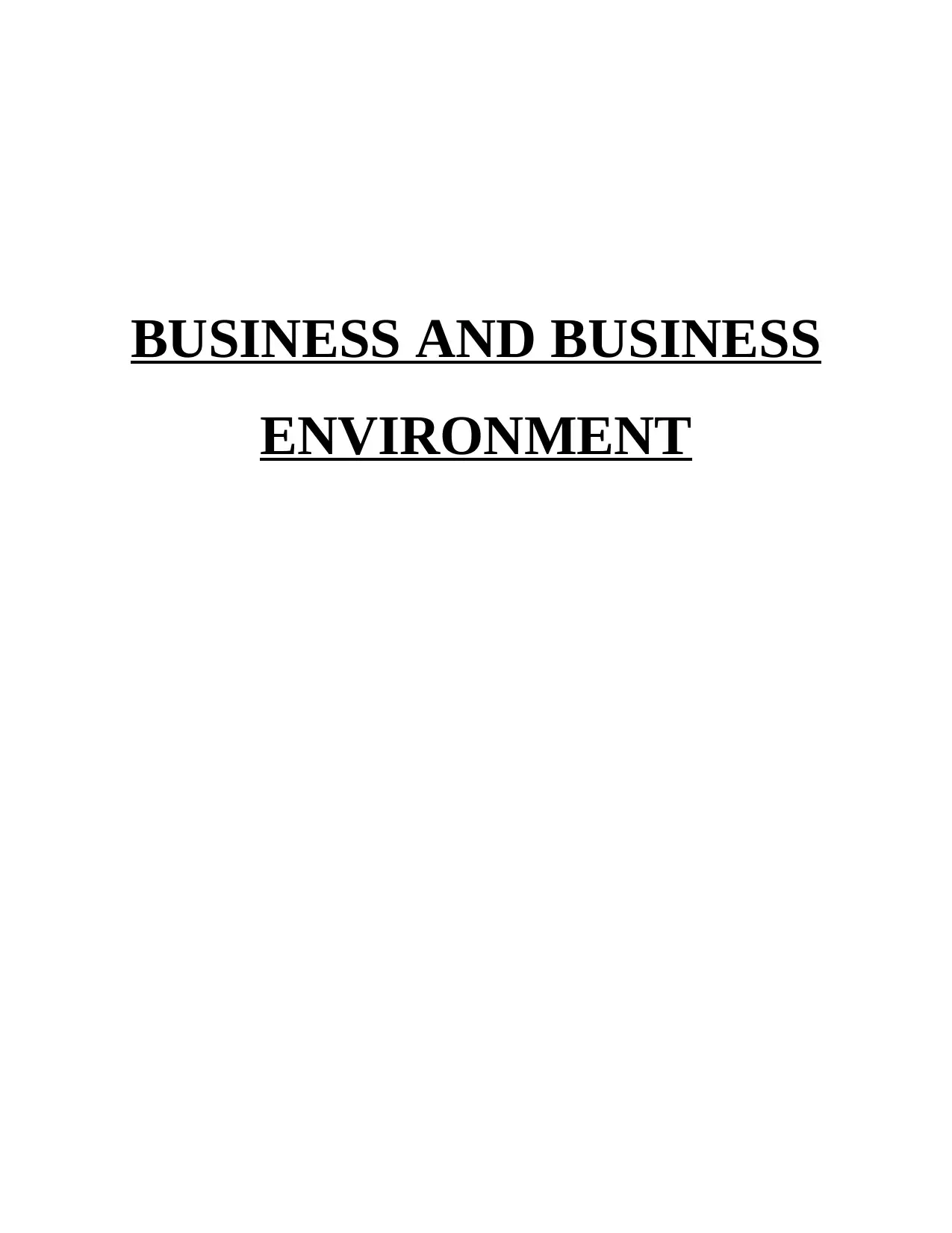
BUSINESS AND BUSINESS
ENVIRONMENT
ENVIRONMENT
Paraphrase This Document
Need a fresh take? Get an instant paraphrase of this document with our AI Paraphraser
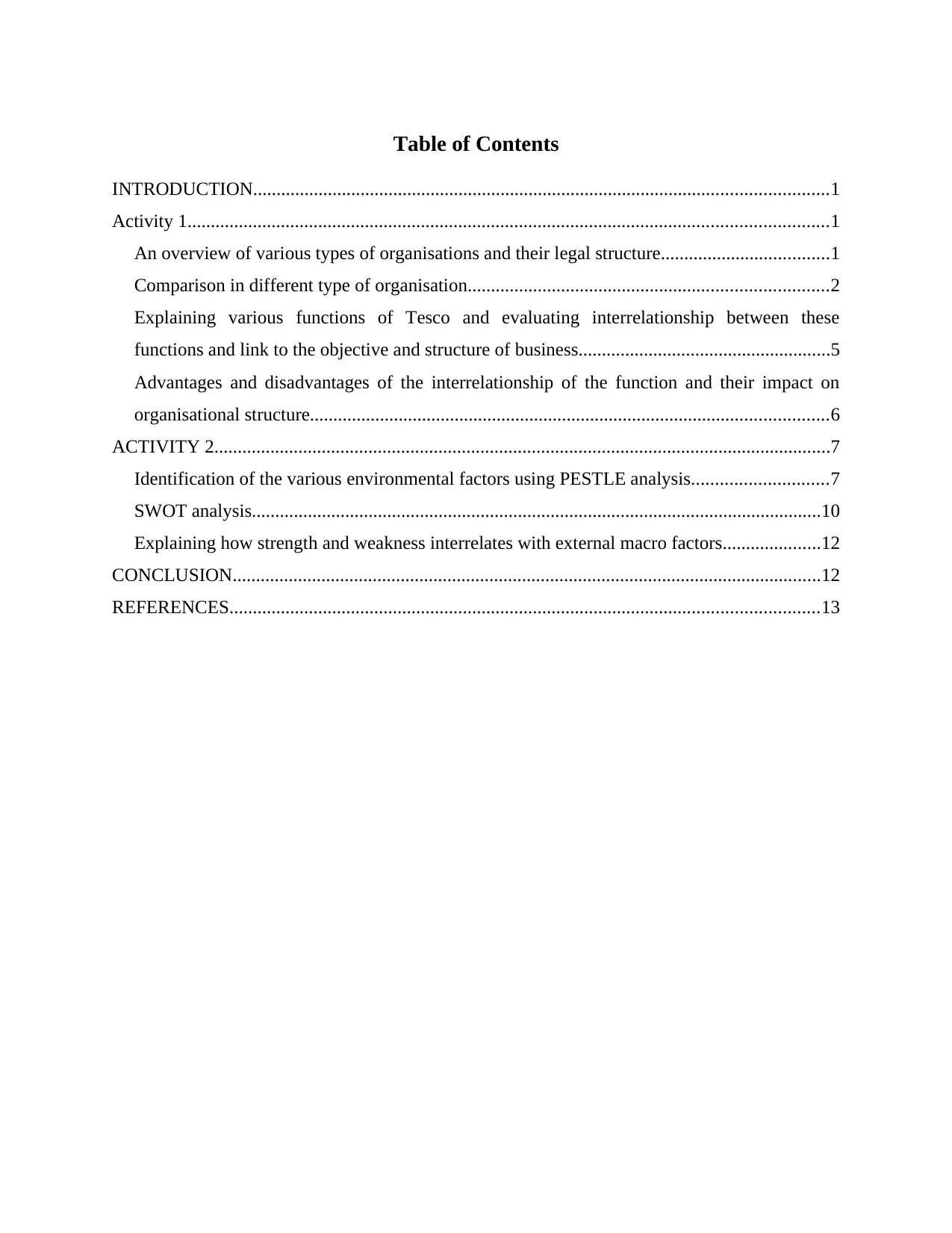
Table of Contents
INTRODUCTION...........................................................................................................................1
Activity 1.........................................................................................................................................1
An overview of various types of organisations and their legal structure....................................1
Comparison in different type of organisation.............................................................................2
Explaining various functions of Tesco and evaluating interrelationship between these
functions and link to the objective and structure of business......................................................5
Advantages and disadvantages of the interrelationship of the function and their impact on
organisational structure...............................................................................................................6
ACTIVITY 2....................................................................................................................................7
Identification of the various environmental factors using PESTLE analysis.............................7
SWOT analysis..........................................................................................................................10
Explaining how strength and weakness interrelates with external macro factors.....................12
CONCLUSION..............................................................................................................................12
REFERENCES..............................................................................................................................13
INTRODUCTION...........................................................................................................................1
Activity 1.........................................................................................................................................1
An overview of various types of organisations and their legal structure....................................1
Comparison in different type of organisation.............................................................................2
Explaining various functions of Tesco and evaluating interrelationship between these
functions and link to the objective and structure of business......................................................5
Advantages and disadvantages of the interrelationship of the function and their impact on
organisational structure...............................................................................................................6
ACTIVITY 2....................................................................................................................................7
Identification of the various environmental factors using PESTLE analysis.............................7
SWOT analysis..........................................................................................................................10
Explaining how strength and weakness interrelates with external macro factors.....................12
CONCLUSION..............................................................................................................................12
REFERENCES..............................................................................................................................13

⊘ This is a preview!⊘
Do you want full access?
Subscribe today to unlock all pages.

Trusted by 1+ million students worldwide
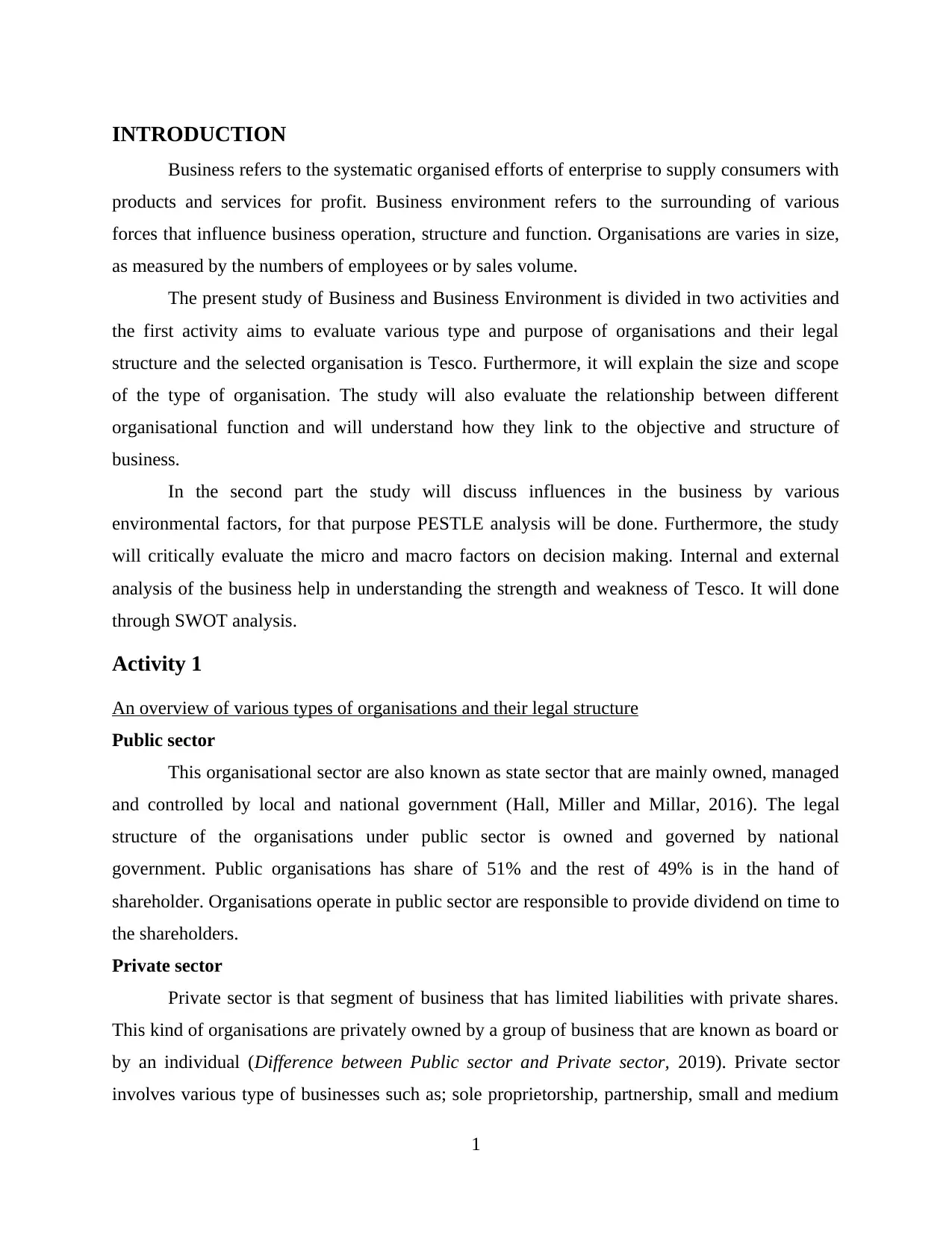
INTRODUCTION
Business refers to the systematic organised efforts of enterprise to supply consumers with
products and services for profit. Business environment refers to the surrounding of various
forces that influence business operation, structure and function. Organisations are varies in size,
as measured by the numbers of employees or by sales volume.
The present study of Business and Business Environment is divided in two activities and
the first activity aims to evaluate various type and purpose of organisations and their legal
structure and the selected organisation is Tesco. Furthermore, it will explain the size and scope
of the type of organisation. The study will also evaluate the relationship between different
organisational function and will understand how they link to the objective and structure of
business.
In the second part the study will discuss influences in the business by various
environmental factors, for that purpose PESTLE analysis will be done. Furthermore, the study
will critically evaluate the micro and macro factors on decision making. Internal and external
analysis of the business help in understanding the strength and weakness of Tesco. It will done
through SWOT analysis.
Activity 1
An overview of various types of organisations and their legal structure
Public sector
This organisational sector are also known as state sector that are mainly owned, managed
and controlled by local and national government (Hall, Miller and Millar, 2016). The legal
structure of the organisations under public sector is owned and governed by national
government. Public organisations has share of 51% and the rest of 49% is in the hand of
shareholder. Organisations operate in public sector are responsible to provide dividend on time to
the shareholders.
Private sector
Private sector is that segment of business that has limited liabilities with private shares.
This kind of organisations are privately owned by a group of business that are known as board or
by an individual (Difference between Public sector and Private sector, 2019). Private sector
involves various type of businesses such as; sole proprietorship, partnership, small and medium
1
Business refers to the systematic organised efforts of enterprise to supply consumers with
products and services for profit. Business environment refers to the surrounding of various
forces that influence business operation, structure and function. Organisations are varies in size,
as measured by the numbers of employees or by sales volume.
The present study of Business and Business Environment is divided in two activities and
the first activity aims to evaluate various type and purpose of organisations and their legal
structure and the selected organisation is Tesco. Furthermore, it will explain the size and scope
of the type of organisation. The study will also evaluate the relationship between different
organisational function and will understand how they link to the objective and structure of
business.
In the second part the study will discuss influences in the business by various
environmental factors, for that purpose PESTLE analysis will be done. Furthermore, the study
will critically evaluate the micro and macro factors on decision making. Internal and external
analysis of the business help in understanding the strength and weakness of Tesco. It will done
through SWOT analysis.
Activity 1
An overview of various types of organisations and their legal structure
Public sector
This organisational sector are also known as state sector that are mainly owned, managed
and controlled by local and national government (Hall, Miller and Millar, 2016). The legal
structure of the organisations under public sector is owned and governed by national
government. Public organisations has share of 51% and the rest of 49% is in the hand of
shareholder. Organisations operate in public sector are responsible to provide dividend on time to
the shareholders.
Private sector
Private sector is that segment of business that has limited liabilities with private shares.
This kind of organisations are privately owned by a group of business that are known as board or
by an individual (Difference between Public sector and Private sector, 2019). Private sector
involves various type of businesses such as; sole proprietorship, partnership, small and medium
1
Paraphrase This Document
Need a fresh take? Get an instant paraphrase of this document with our AI Paraphraser
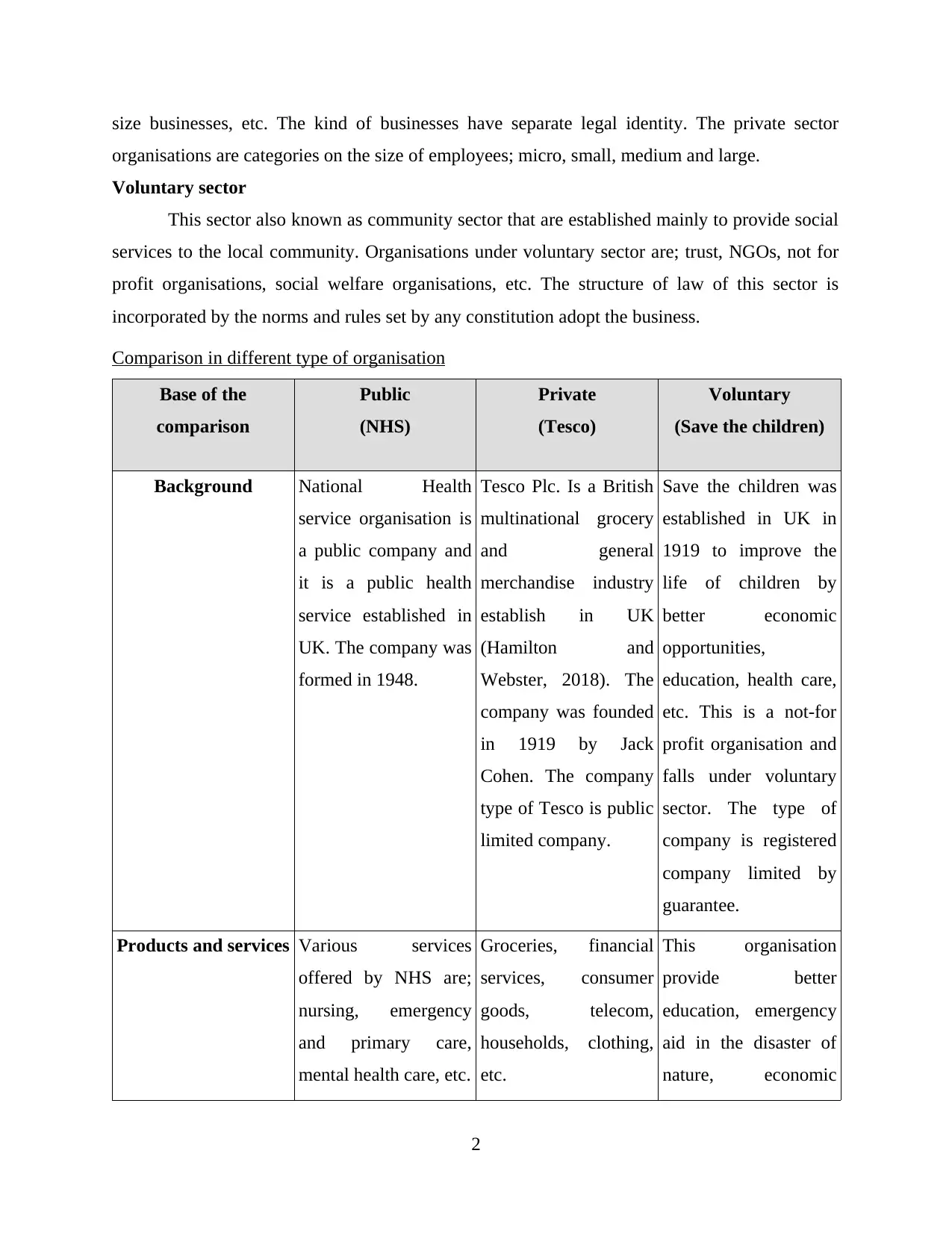
size businesses, etc. The kind of businesses have separate legal identity. The private sector
organisations are categories on the size of employees; micro, small, medium and large.
Voluntary sector
This sector also known as community sector that are established mainly to provide social
services to the local community. Organisations under voluntary sector are; trust, NGOs, not for
profit organisations, social welfare organisations, etc. The structure of law of this sector is
incorporated by the norms and rules set by any constitution adopt the business.
Comparison in different type of organisation
Base of the
comparison
Public
(NHS)
Private
(Tesco)
Voluntary
(Save the children)
Background National Health
service organisation is
a public company and
it is a public health
service established in
UK. The company was
formed in 1948.
Tesco Plc. Is a British
multinational grocery
and general
merchandise industry
establish in UK
(Hamilton and
Webster, 2018). The
company was founded
in 1919 by Jack
Cohen. The company
type of Tesco is public
limited company.
Save the children was
established in UK in
1919 to improve the
life of children by
better economic
opportunities,
education, health care,
etc. This is a not-for
profit organisation and
falls under voluntary
sector. The type of
company is registered
company limited by
guarantee.
Products and services Various services
offered by NHS are;
nursing, emergency
and primary care,
mental health care, etc.
Groceries, financial
services, consumer
goods, telecom,
households, clothing,
etc.
This organisation
provide better
education, emergency
aid in the disaster of
nature, economic
2
organisations are categories on the size of employees; micro, small, medium and large.
Voluntary sector
This sector also known as community sector that are established mainly to provide social
services to the local community. Organisations under voluntary sector are; trust, NGOs, not for
profit organisations, social welfare organisations, etc. The structure of law of this sector is
incorporated by the norms and rules set by any constitution adopt the business.
Comparison in different type of organisation
Base of the
comparison
Public
(NHS)
Private
(Tesco)
Voluntary
(Save the children)
Background National Health
service organisation is
a public company and
it is a public health
service established in
UK. The company was
formed in 1948.
Tesco Plc. Is a British
multinational grocery
and general
merchandise industry
establish in UK
(Hamilton and
Webster, 2018). The
company was founded
in 1919 by Jack
Cohen. The company
type of Tesco is public
limited company.
Save the children was
established in UK in
1919 to improve the
life of children by
better economic
opportunities,
education, health care,
etc. This is a not-for
profit organisation and
falls under voluntary
sector. The type of
company is registered
company limited by
guarantee.
Products and services Various services
offered by NHS are;
nursing, emergency
and primary care,
mental health care, etc.
Groceries, financial
services, consumer
goods, telecom,
households, clothing,
etc.
This organisation
provide better
education, emergency
aid in the disaster of
nature, economic
2
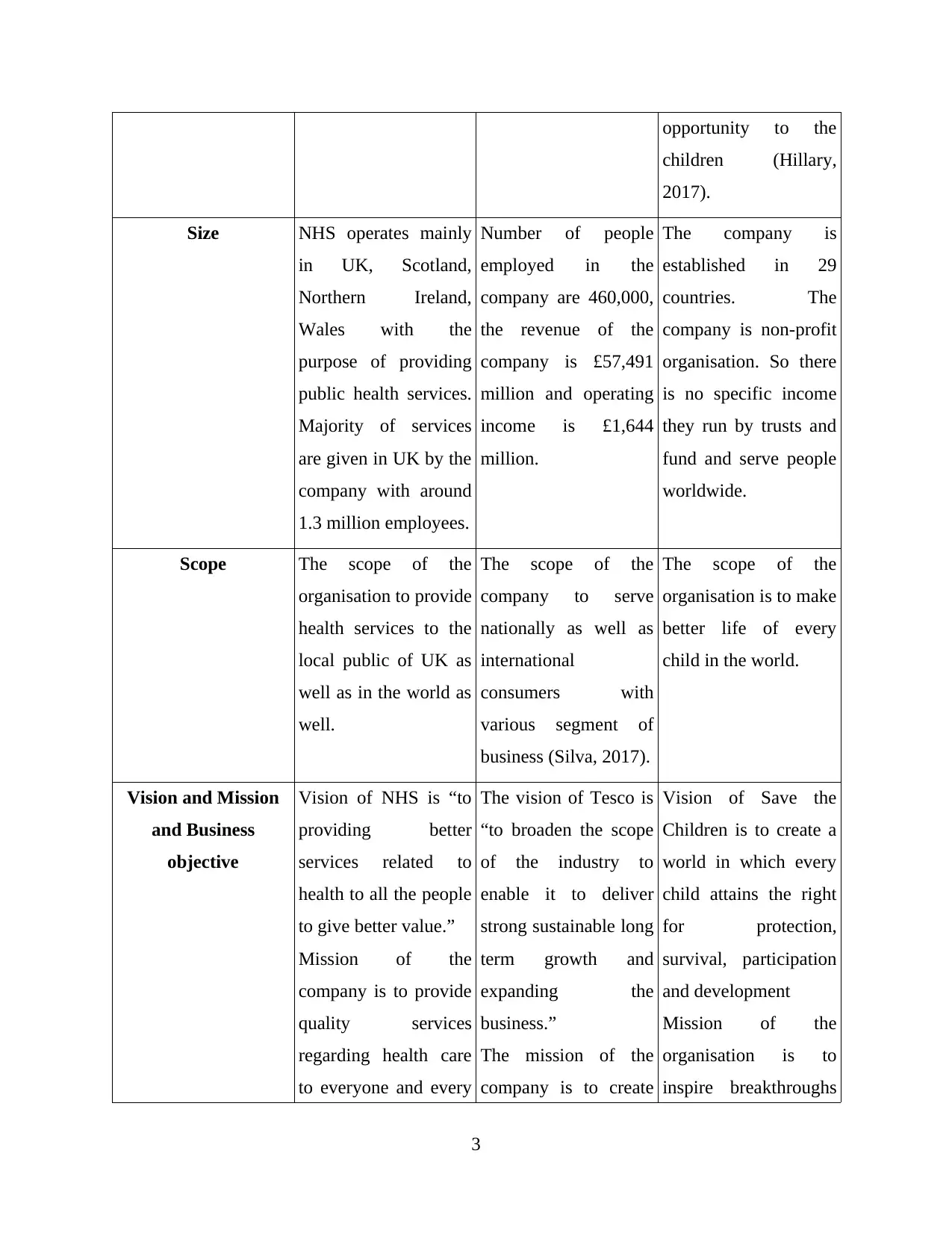
opportunity to the
children (Hillary,
2017).
Size NHS operates mainly
in UK, Scotland,
Northern Ireland,
Wales with the
purpose of providing
public health services.
Majority of services
are given in UK by the
company with around
1.3 million employees.
Number of people
employed in the
company are 460,000,
the revenue of the
company is £57,491
million and operating
income is £1,644
million.
The company is
established in 29
countries. The
company is non-profit
organisation. So there
is no specific income
they run by trusts and
fund and serve people
worldwide.
Scope The scope of the
organisation to provide
health services to the
local public of UK as
well as in the world as
well.
The scope of the
company to serve
nationally as well as
international
consumers with
various segment of
business (Silva, 2017).
The scope of the
organisation is to make
better life of every
child in the world.
Vision and Mission
and Business
objective
Vision of NHS is “to
providing better
services related to
health to all the people
to give better value.”
Mission of the
company is to provide
quality services
regarding health care
to everyone and every
The vision of Tesco is
“to broaden the scope
of the industry to
enable it to deliver
strong sustainable long
term growth and
expanding the
business.”
The mission of the
company is to create
Vision of Save the
Children is to create a
world in which every
child attains the right
for protection,
survival, participation
and development
Mission of the
organisation is to
inspire breakthroughs
3
children (Hillary,
2017).
Size NHS operates mainly
in UK, Scotland,
Northern Ireland,
Wales with the
purpose of providing
public health services.
Majority of services
are given in UK by the
company with around
1.3 million employees.
Number of people
employed in the
company are 460,000,
the revenue of the
company is £57,491
million and operating
income is £1,644
million.
The company is
established in 29
countries. The
company is non-profit
organisation. So there
is no specific income
they run by trusts and
fund and serve people
worldwide.
Scope The scope of the
organisation to provide
health services to the
local public of UK as
well as in the world as
well.
The scope of the
company to serve
nationally as well as
international
consumers with
various segment of
business (Silva, 2017).
The scope of the
organisation is to make
better life of every
child in the world.
Vision and Mission
and Business
objective
Vision of NHS is “to
providing better
services related to
health to all the people
to give better value.”
Mission of the
company is to provide
quality services
regarding health care
to everyone and every
The vision of Tesco is
“to broaden the scope
of the industry to
enable it to deliver
strong sustainable long
term growth and
expanding the
business.”
The mission of the
company is to create
Vision of Save the
Children is to create a
world in which every
child attains the right
for protection,
survival, participation
and development
Mission of the
organisation is to
inspire breakthroughs
3
⊘ This is a preview!⊘
Do you want full access?
Subscribe today to unlock all pages.

Trusted by 1+ million students worldwide
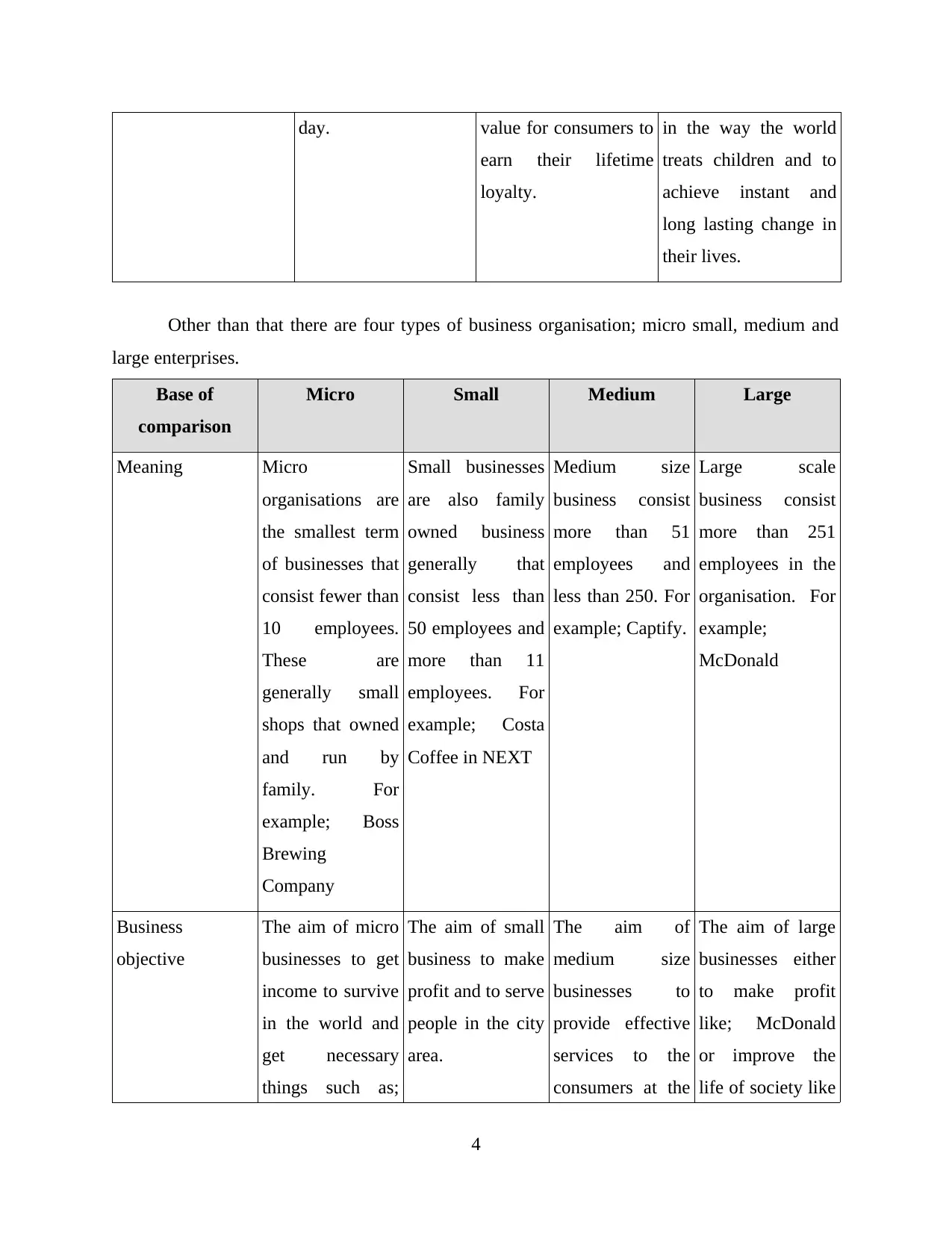
day. value for consumers to
earn their lifetime
loyalty.
in the way the world
treats children and to
achieve instant and
long lasting change in
their lives.
Other than that there are four types of business organisation; micro small, medium and
large enterprises.
Base of
comparison
Micro Small Medium Large
Meaning Micro
organisations are
the smallest term
of businesses that
consist fewer than
10 employees.
These are
generally small
shops that owned
and run by
family. For
example; Boss
Brewing
Company
Small businesses
are also family
owned business
generally that
consist less than
50 employees and
more than 11
employees. For
example; Costa
Coffee in NEXT
Medium size
business consist
more than 51
employees and
less than 250. For
example; Captify.
Large scale
business consist
more than 251
employees in the
organisation. For
example;
McDonald
Business
objective
The aim of micro
businesses to get
income to survive
in the world and
get necessary
things such as;
The aim of small
business to make
profit and to serve
people in the city
area.
The aim of
medium size
businesses to
provide effective
services to the
consumers at the
The aim of large
businesses either
to make profit
like; McDonald
or improve the
life of society like
4
earn their lifetime
loyalty.
in the way the world
treats children and to
achieve instant and
long lasting change in
their lives.
Other than that there are four types of business organisation; micro small, medium and
large enterprises.
Base of
comparison
Micro Small Medium Large
Meaning Micro
organisations are
the smallest term
of businesses that
consist fewer than
10 employees.
These are
generally small
shops that owned
and run by
family. For
example; Boss
Brewing
Company
Small businesses
are also family
owned business
generally that
consist less than
50 employees and
more than 11
employees. For
example; Costa
Coffee in NEXT
Medium size
business consist
more than 51
employees and
less than 250. For
example; Captify.
Large scale
business consist
more than 251
employees in the
organisation. For
example;
McDonald
Business
objective
The aim of micro
businesses to get
income to survive
in the world and
get necessary
things such as;
The aim of small
business to make
profit and to serve
people in the city
area.
The aim of
medium size
businesses to
provide effective
services to the
consumers at the
The aim of large
businesses either
to make profit
like; McDonald
or improve the
life of society like
4
Paraphrase This Document
Need a fresh take? Get an instant paraphrase of this document with our AI Paraphraser
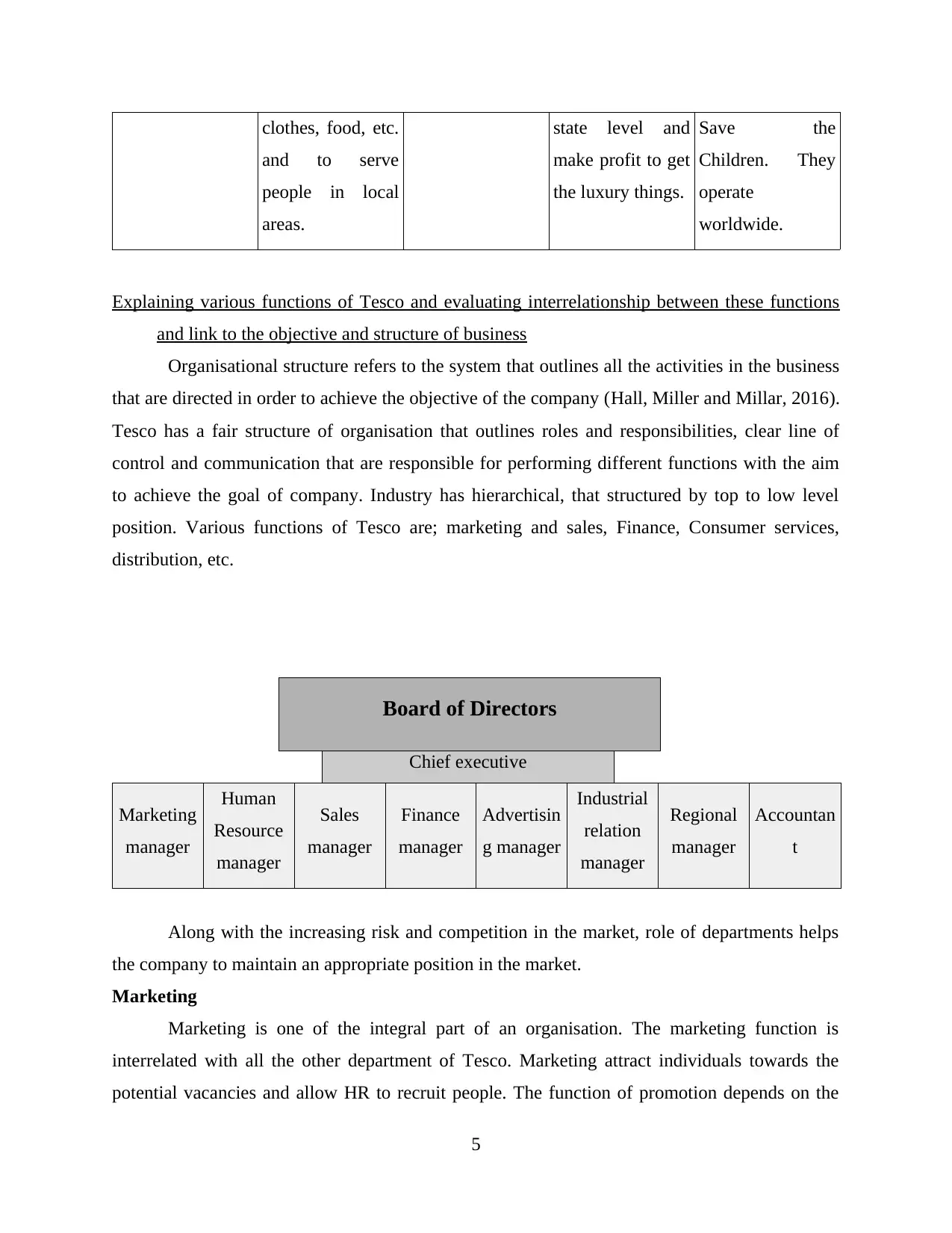
clothes, food, etc.
and to serve
people in local
areas.
state level and
make profit to get
the luxury things.
Save the
Children. They
operate
worldwide.
Explaining various functions of Tesco and evaluating interrelationship between these functions
and link to the objective and structure of business
Organisational structure refers to the system that outlines all the activities in the business
that are directed in order to achieve the objective of the company (Hall, Miller and Millar, 2016).
Tesco has a fair structure of organisation that outlines roles and responsibilities, clear line of
control and communication that are responsible for performing different functions with the aim
to achieve the goal of company. Industry has hierarchical, that structured by top to low level
position. Various functions of Tesco are; marketing and sales, Finance, Consumer services,
distribution, etc.
Board of Directors
Chief executive
Marketing
manager
Human
Resource
manager
Sales
manager
Finance
manager
Advertisin
g manager
Industrial
relation
manager
Regional
manager
Accountan
t
Along with the increasing risk and competition in the market, role of departments helps
the company to maintain an appropriate position in the market.
Marketing
Marketing is one of the integral part of an organisation. The marketing function is
interrelated with all the other department of Tesco. Marketing attract individuals towards the
potential vacancies and allow HR to recruit people. The function of promotion depends on the
5
and to serve
people in local
areas.
state level and
make profit to get
the luxury things.
Save the
Children. They
operate
worldwide.
Explaining various functions of Tesco and evaluating interrelationship between these functions
and link to the objective and structure of business
Organisational structure refers to the system that outlines all the activities in the business
that are directed in order to achieve the objective of the company (Hall, Miller and Millar, 2016).
Tesco has a fair structure of organisation that outlines roles and responsibilities, clear line of
control and communication that are responsible for performing different functions with the aim
to achieve the goal of company. Industry has hierarchical, that structured by top to low level
position. Various functions of Tesco are; marketing and sales, Finance, Consumer services,
distribution, etc.
Board of Directors
Chief executive
Marketing
manager
Human
Resource
manager
Sales
manager
Finance
manager
Advertisin
g manager
Industrial
relation
manager
Regional
manager
Accountan
t
Along with the increasing risk and competition in the market, role of departments helps
the company to maintain an appropriate position in the market.
Marketing
Marketing is one of the integral part of an organisation. The marketing function is
interrelated with all the other department of Tesco. Marketing attract individuals towards the
potential vacancies and allow HR to recruit people. The function of promotion depends on the
5
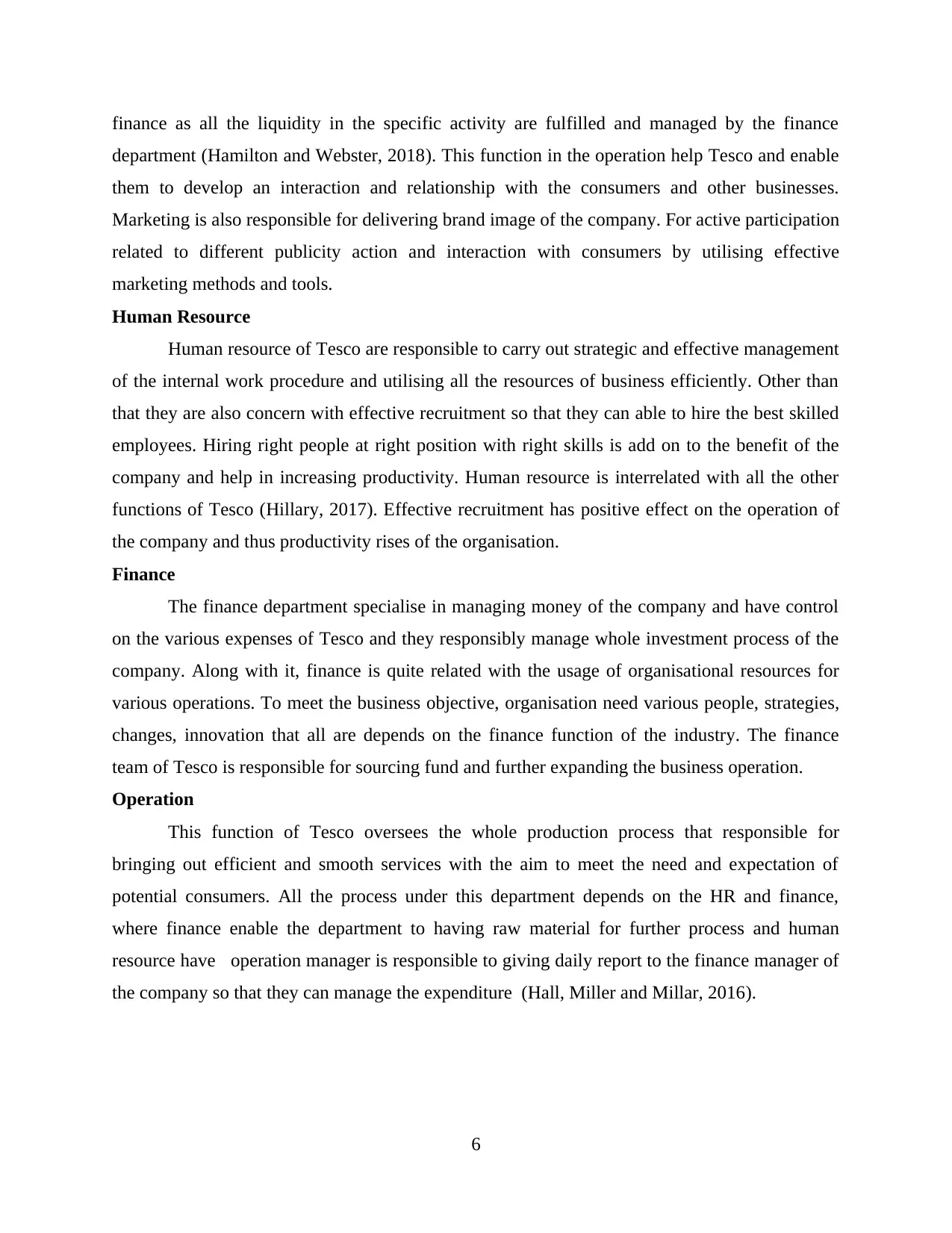
finance as all the liquidity in the specific activity are fulfilled and managed by the finance
department (Hamilton and Webster, 2018). This function in the operation help Tesco and enable
them to develop an interaction and relationship with the consumers and other businesses.
Marketing is also responsible for delivering brand image of the company. For active participation
related to different publicity action and interaction with consumers by utilising effective
marketing methods and tools.
Human Resource
Human resource of Tesco are responsible to carry out strategic and effective management
of the internal work procedure and utilising all the resources of business efficiently. Other than
that they are also concern with effective recruitment so that they can able to hire the best skilled
employees. Hiring right people at right position with right skills is add on to the benefit of the
company and help in increasing productivity. Human resource is interrelated with all the other
functions of Tesco (Hillary, 2017). Effective recruitment has positive effect on the operation of
the company and thus productivity rises of the organisation.
Finance
The finance department specialise in managing money of the company and have control
on the various expenses of Tesco and they responsibly manage whole investment process of the
company. Along with it, finance is quite related with the usage of organisational resources for
various operations. To meet the business objective, organisation need various people, strategies,
changes, innovation that all are depends on the finance function of the industry. The finance
team of Tesco is responsible for sourcing fund and further expanding the business operation.
Operation
This function of Tesco oversees the whole production process that responsible for
bringing out efficient and smooth services with the aim to meet the need and expectation of
potential consumers. All the process under this department depends on the HR and finance,
where finance enable the department to having raw material for further process and human
resource have operation manager is responsible to giving daily report to the finance manager of
the company so that they can manage the expenditure (Hall, Miller and Millar, 2016).
6
department (Hamilton and Webster, 2018). This function in the operation help Tesco and enable
them to develop an interaction and relationship with the consumers and other businesses.
Marketing is also responsible for delivering brand image of the company. For active participation
related to different publicity action and interaction with consumers by utilising effective
marketing methods and tools.
Human Resource
Human resource of Tesco are responsible to carry out strategic and effective management
of the internal work procedure and utilising all the resources of business efficiently. Other than
that they are also concern with effective recruitment so that they can able to hire the best skilled
employees. Hiring right people at right position with right skills is add on to the benefit of the
company and help in increasing productivity. Human resource is interrelated with all the other
functions of Tesco (Hillary, 2017). Effective recruitment has positive effect on the operation of
the company and thus productivity rises of the organisation.
Finance
The finance department specialise in managing money of the company and have control
on the various expenses of Tesco and they responsibly manage whole investment process of the
company. Along with it, finance is quite related with the usage of organisational resources for
various operations. To meet the business objective, organisation need various people, strategies,
changes, innovation that all are depends on the finance function of the industry. The finance
team of Tesco is responsible for sourcing fund and further expanding the business operation.
Operation
This function of Tesco oversees the whole production process that responsible for
bringing out efficient and smooth services with the aim to meet the need and expectation of
potential consumers. All the process under this department depends on the HR and finance,
where finance enable the department to having raw material for further process and human
resource have operation manager is responsible to giving daily report to the finance manager of
the company so that they can manage the expenditure (Hall, Miller and Millar, 2016).
6
⊘ This is a preview!⊘
Do you want full access?
Subscribe today to unlock all pages.

Trusted by 1+ million students worldwide
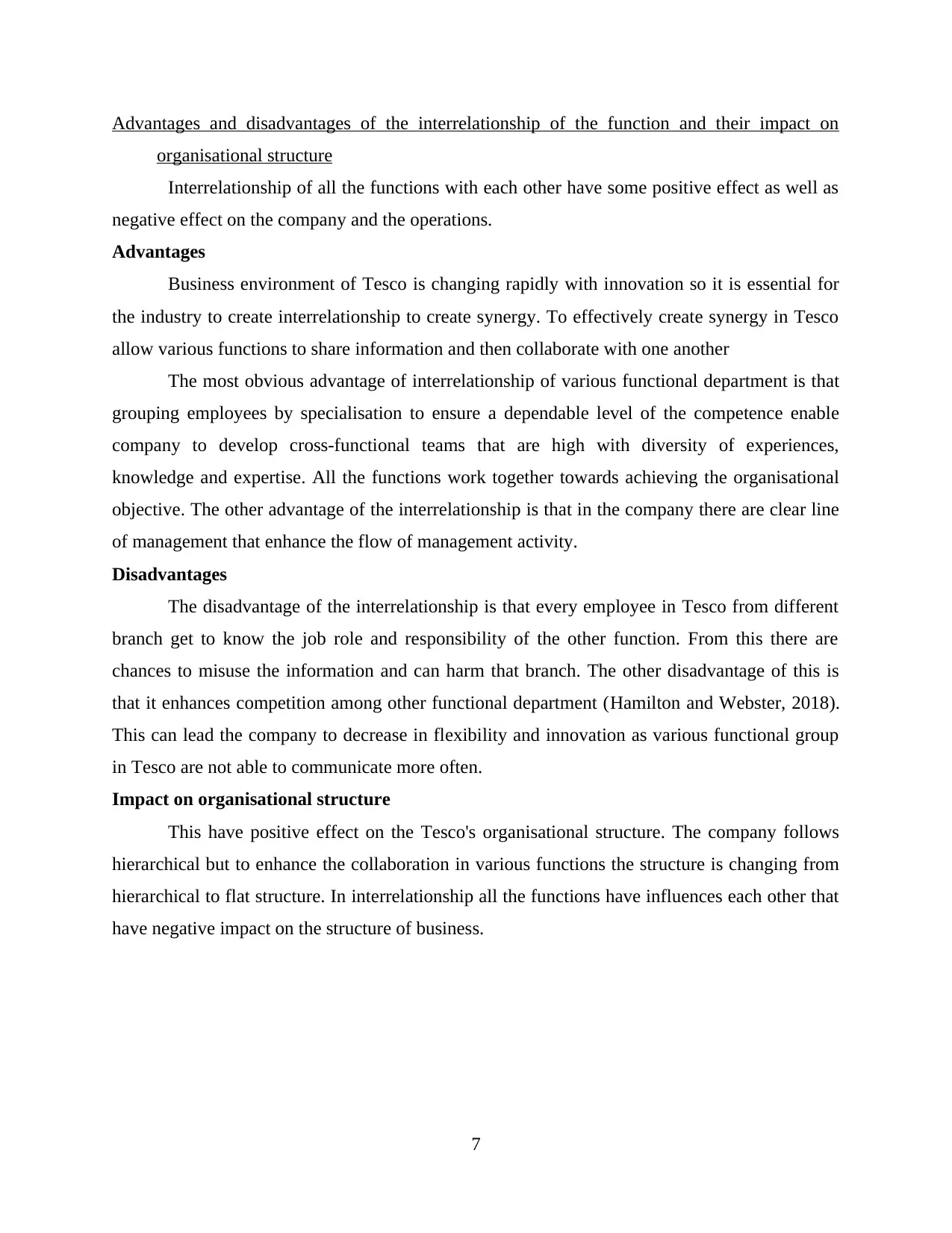
Advantages and disadvantages of the interrelationship of the function and their impact on
organisational structure
Interrelationship of all the functions with each other have some positive effect as well as
negative effect on the company and the operations.
Advantages
Business environment of Tesco is changing rapidly with innovation so it is essential for
the industry to create interrelationship to create synergy. To effectively create synergy in Tesco
allow various functions to share information and then collaborate with one another
The most obvious advantage of interrelationship of various functional department is that
grouping employees by specialisation to ensure a dependable level of the competence enable
company to develop cross-functional teams that are high with diversity of experiences,
knowledge and expertise. All the functions work together towards achieving the organisational
objective. The other advantage of the interrelationship is that in the company there are clear line
of management that enhance the flow of management activity.
Disadvantages
The disadvantage of the interrelationship is that every employee in Tesco from different
branch get to know the job role and responsibility of the other function. From this there are
chances to misuse the information and can harm that branch. The other disadvantage of this is
that it enhances competition among other functional department (Hamilton and Webster, 2018).
This can lead the company to decrease in flexibility and innovation as various functional group
in Tesco are not able to communicate more often.
Impact on organisational structure
This have positive effect on the Tesco's organisational structure. The company follows
hierarchical but to enhance the collaboration in various functions the structure is changing from
hierarchical to flat structure. In interrelationship all the functions have influences each other that
have negative impact on the structure of business.
7
organisational structure
Interrelationship of all the functions with each other have some positive effect as well as
negative effect on the company and the operations.
Advantages
Business environment of Tesco is changing rapidly with innovation so it is essential for
the industry to create interrelationship to create synergy. To effectively create synergy in Tesco
allow various functions to share information and then collaborate with one another
The most obvious advantage of interrelationship of various functional department is that
grouping employees by specialisation to ensure a dependable level of the competence enable
company to develop cross-functional teams that are high with diversity of experiences,
knowledge and expertise. All the functions work together towards achieving the organisational
objective. The other advantage of the interrelationship is that in the company there are clear line
of management that enhance the flow of management activity.
Disadvantages
The disadvantage of the interrelationship is that every employee in Tesco from different
branch get to know the job role and responsibility of the other function. From this there are
chances to misuse the information and can harm that branch. The other disadvantage of this is
that it enhances competition among other functional department (Hamilton and Webster, 2018).
This can lead the company to decrease in flexibility and innovation as various functional group
in Tesco are not able to communicate more often.
Impact on organisational structure
This have positive effect on the Tesco's organisational structure. The company follows
hierarchical but to enhance the collaboration in various functions the structure is changing from
hierarchical to flat structure. In interrelationship all the functions have influences each other that
have negative impact on the structure of business.
7
Paraphrase This Document
Need a fresh take? Get an instant paraphrase of this document with our AI Paraphraser
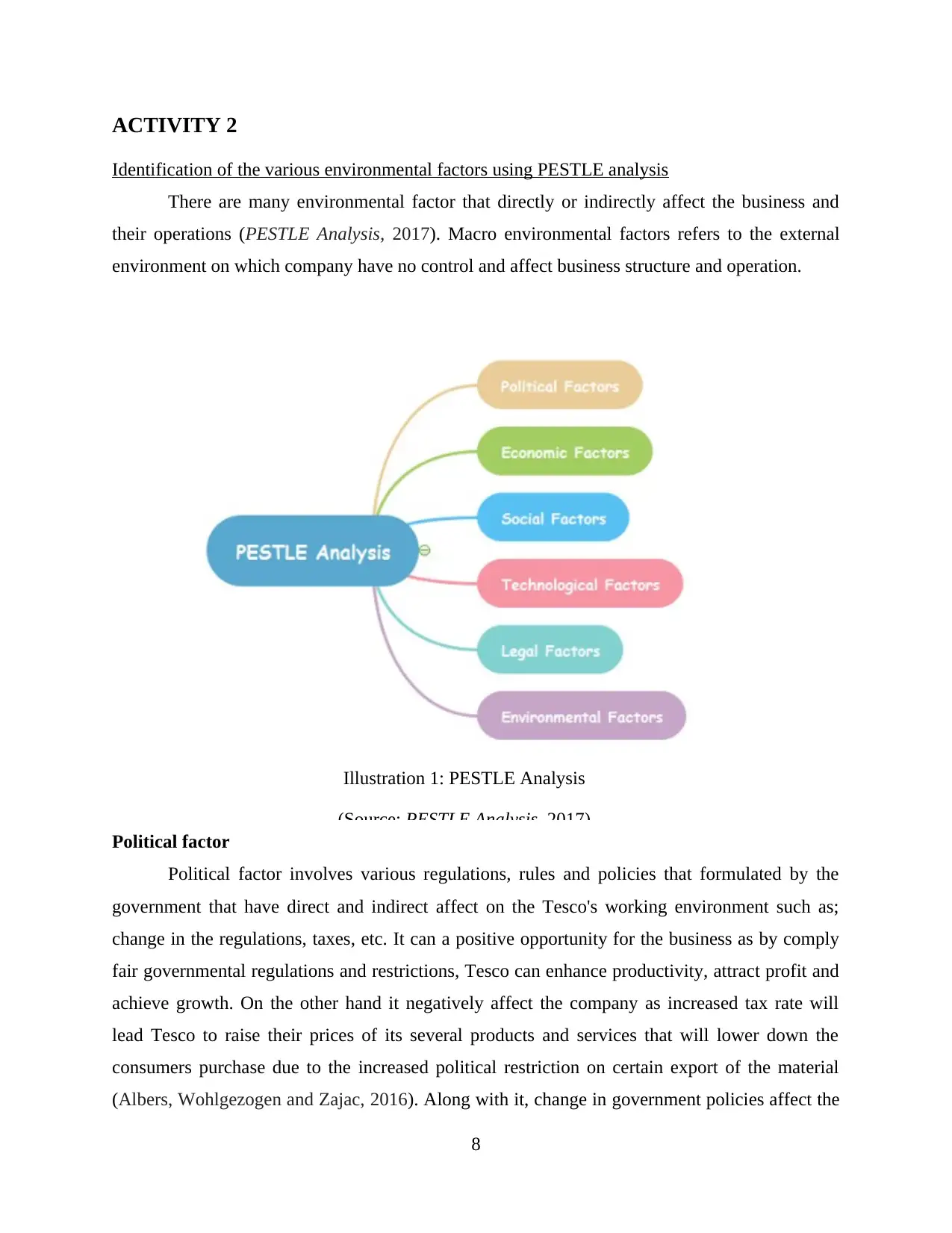
ACTIVITY 2
Identification of the various environmental factors using PESTLE analysis
There are many environmental factor that directly or indirectly affect the business and
their operations (PESTLE Analysis, 2017). Macro environmental factors refers to the external
environment on which company have no control and affect business structure and operation.
Political factor
Political factor involves various regulations, rules and policies that formulated by the
government that have direct and indirect affect on the Tesco's working environment such as;
change in the regulations, taxes, etc. It can a positive opportunity for the business as by comply
fair governmental regulations and restrictions, Tesco can enhance productivity, attract profit and
achieve growth. On the other hand it negatively affect the company as increased tax rate will
lead Tesco to raise their prices of its several products and services that will lower down the
consumers purchase due to the increased political restriction on certain export of the material
(Albers, Wohlgezogen and Zajac, 2016). Along with it, change in government policies affect the
8
Illustration 1: PESTLE Analysis
(Source: PESTLE Analysis, 2017)
Identification of the various environmental factors using PESTLE analysis
There are many environmental factor that directly or indirectly affect the business and
their operations (PESTLE Analysis, 2017). Macro environmental factors refers to the external
environment on which company have no control and affect business structure and operation.
Political factor
Political factor involves various regulations, rules and policies that formulated by the
government that have direct and indirect affect on the Tesco's working environment such as;
change in the regulations, taxes, etc. It can a positive opportunity for the business as by comply
fair governmental regulations and restrictions, Tesco can enhance productivity, attract profit and
achieve growth. On the other hand it negatively affect the company as increased tax rate will
lead Tesco to raise their prices of its several products and services that will lower down the
consumers purchase due to the increased political restriction on certain export of the material
(Albers, Wohlgezogen and Zajac, 2016). Along with it, change in government policies affect the
8
Illustration 1: PESTLE Analysis
(Source: PESTLE Analysis, 2017)
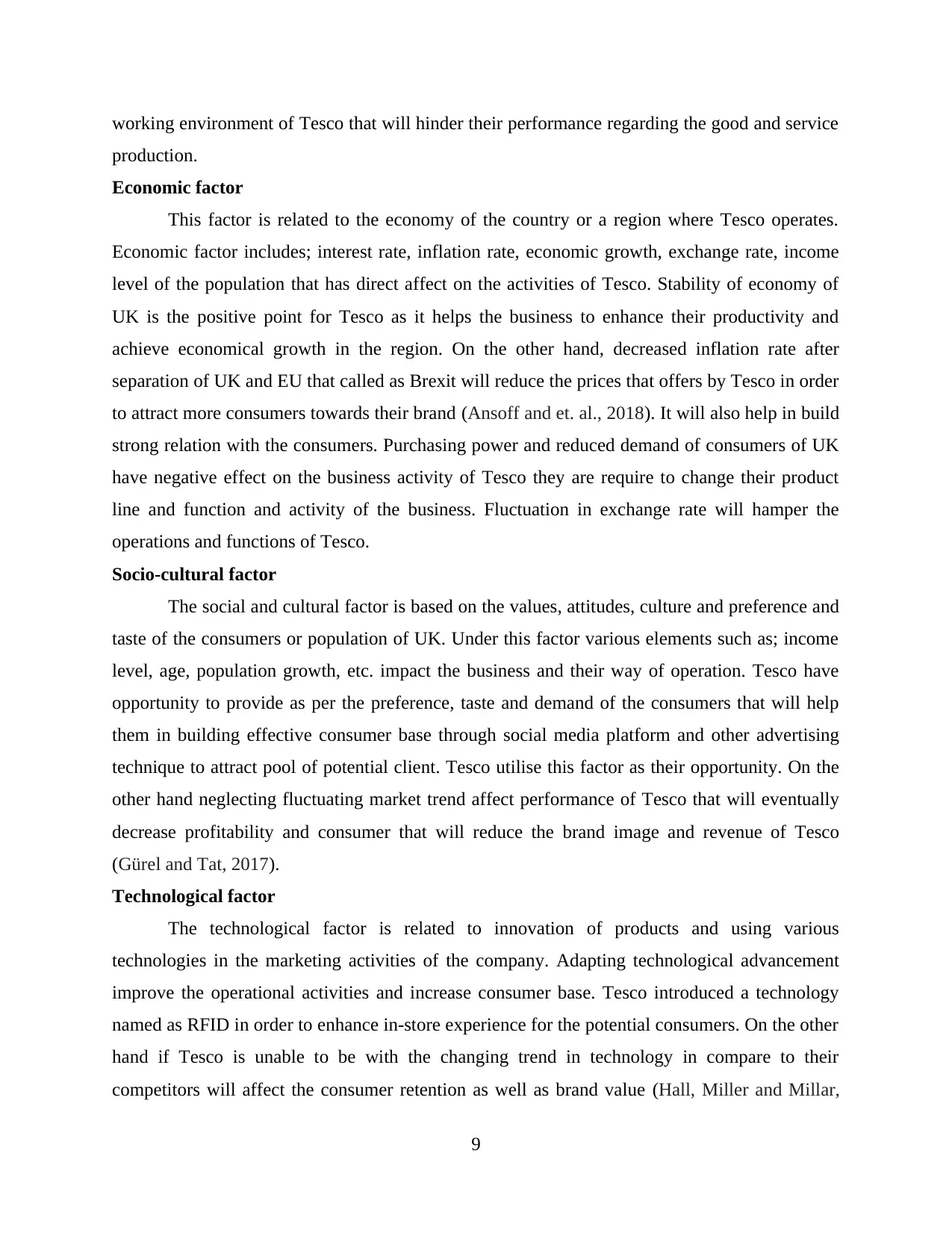
working environment of Tesco that will hinder their performance regarding the good and service
production.
Economic factor
This factor is related to the economy of the country or a region where Tesco operates.
Economic factor includes; interest rate, inflation rate, economic growth, exchange rate, income
level of the population that has direct affect on the activities of Tesco. Stability of economy of
UK is the positive point for Tesco as it helps the business to enhance their productivity and
achieve economical growth in the region. On the other hand, decreased inflation rate after
separation of UK and EU that called as Brexit will reduce the prices that offers by Tesco in order
to attract more consumers towards their brand (Ansoff and et. al., 2018). It will also help in build
strong relation with the consumers. Purchasing power and reduced demand of consumers of UK
have negative effect on the business activity of Tesco they are require to change their product
line and function and activity of the business. Fluctuation in exchange rate will hamper the
operations and functions of Tesco.
Socio-cultural factor
The social and cultural factor is based on the values, attitudes, culture and preference and
taste of the consumers or population of UK. Under this factor various elements such as; income
level, age, population growth, etc. impact the business and their way of operation. Tesco have
opportunity to provide as per the preference, taste and demand of the consumers that will help
them in building effective consumer base through social media platform and other advertising
technique to attract pool of potential client. Tesco utilise this factor as their opportunity. On the
other hand neglecting fluctuating market trend affect performance of Tesco that will eventually
decrease profitability and consumer that will reduce the brand image and revenue of Tesco
(Gürel and Tat, 2017).
Technological factor
The technological factor is related to innovation of products and using various
technologies in the marketing activities of the company. Adapting technological advancement
improve the operational activities and increase consumer base. Tesco introduced a technology
named as RFID in order to enhance in-store experience for the potential consumers. On the other
hand if Tesco is unable to be with the changing trend in technology in compare to their
competitors will affect the consumer retention as well as brand value (Hall, Miller and Millar,
9
production.
Economic factor
This factor is related to the economy of the country or a region where Tesco operates.
Economic factor includes; interest rate, inflation rate, economic growth, exchange rate, income
level of the population that has direct affect on the activities of Tesco. Stability of economy of
UK is the positive point for Tesco as it helps the business to enhance their productivity and
achieve economical growth in the region. On the other hand, decreased inflation rate after
separation of UK and EU that called as Brexit will reduce the prices that offers by Tesco in order
to attract more consumers towards their brand (Ansoff and et. al., 2018). It will also help in build
strong relation with the consumers. Purchasing power and reduced demand of consumers of UK
have negative effect on the business activity of Tesco they are require to change their product
line and function and activity of the business. Fluctuation in exchange rate will hamper the
operations and functions of Tesco.
Socio-cultural factor
The social and cultural factor is based on the values, attitudes, culture and preference and
taste of the consumers or population of UK. Under this factor various elements such as; income
level, age, population growth, etc. impact the business and their way of operation. Tesco have
opportunity to provide as per the preference, taste and demand of the consumers that will help
them in building effective consumer base through social media platform and other advertising
technique to attract pool of potential client. Tesco utilise this factor as their opportunity. On the
other hand neglecting fluctuating market trend affect performance of Tesco that will eventually
decrease profitability and consumer that will reduce the brand image and revenue of Tesco
(Gürel and Tat, 2017).
Technological factor
The technological factor is related to innovation of products and using various
technologies in the marketing activities of the company. Adapting technological advancement
improve the operational activities and increase consumer base. Tesco introduced a technology
named as RFID in order to enhance in-store experience for the potential consumers. On the other
hand if Tesco is unable to be with the changing trend in technology in compare to their
competitors will affect the consumer retention as well as brand value (Hall, Miller and Millar,
9
⊘ This is a preview!⊘
Do you want full access?
Subscribe today to unlock all pages.

Trusted by 1+ million students worldwide
1 out of 16
Related Documents
Your All-in-One AI-Powered Toolkit for Academic Success.
+13062052269
info@desklib.com
Available 24*7 on WhatsApp / Email
![[object Object]](/_next/static/media/star-bottom.7253800d.svg)
Unlock your academic potential
Copyright © 2020–2025 A2Z Services. All Rights Reserved. Developed and managed by ZUCOL.





